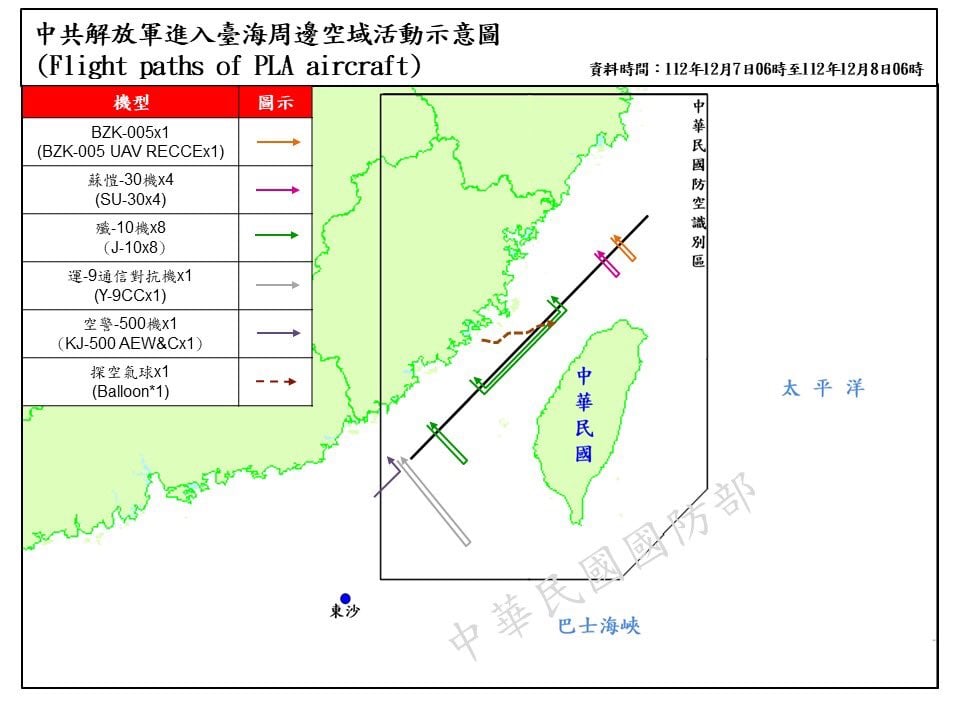
Taiwan’s Ministry of National Defense (MND) reported on Friday that a balloon from China crossed the median line of the Taiwan Strait on Thursday, though they later on Friday clarified it was probably a weather balloon. Meanwhile, a U.S. Navy littoral combat ship carried out drills with the Japan Maritime Self Defense Force (JMSDF) in the South China Sea from Wednesday to Thursday.
On Friday, as part of its daily release on nearby Chinese military activities, Taiwan’s MND reported that at 11.52 a.m. on Thursday, a Chinese balloon was detected crossing the median line in a location 101 nautical miles southwest of Keelung, Taiwan, at an altitude of approximately 21,000 feet. The balloon headed east and disappeared at 12.55 p.m., stated the MND release. Later, while speaking to reporters at Parliament, Taiwan Defence Minister Chiu Kuo-cheng said the balloon was probably a weather balloon.
The balloon’s sighting comes a month before Taiwan’s presidential election. China has been conducting sea and air movements around Taiwan, though the aircraft numbers have been low compared to Sept. 18, when 103 aircraft operated around Taiwan during a 24 hour period. Friday’s report stated that from 6 a.m. Thursday to 6 a.m. Friday, 26 People’s Liberation Army (PLA) aircraft and 10 People’s Liberation Army Navy (PLAN) aircraft were detected operating around Taiwan, with 15 of the aircraft crossing the median line or entering Taiwan’s southwest Air Defence Identification Zone (ADIZ). The aircraft consisted of one BZK-005 reconnaissance UAV, four Su-30 and eight J-10 fighters, one Y-9 surveillance aircraft and KJ-500 Airborne Early Warning and Control (AEW&C) aircraft.
Balloons originating from China have been viewed with suspicion because they are used for surveillance and intelligence gathering, with the U.S shooting down a Chinese surveillance balloon in February. Japan stated that there have been instances of unidentified objects and surveillance balloons sighted over Japan but declined to state they originated from China.
Earlier on Wednesday, a Navy P-8A Poseidon conducted a Taiwan Strait transit, the fifth such transit carried out by a P-8A this year. A Navy release stated: “The aircraft’s transit of the Taiwan Strait demonstrates the United States’ commitment to a free and open Indo-Pacific. The United States military flies, sails and operates anywhere international law allows”.
The PLA’s Eastern Theater Command issued a release quoting the command’s spokesperson Col Shi Yi stating that a P-8 passed through the Taiwan Strait and was “publicly hyped,” though the Navy did not issue any public statement on the flight until after the PLA release. “The Eastern Theater Command of the Chinese People’s Liberation Army organized fighter planes to monitor and monitor the passage of U.S. aircraft, and dealt with them in accordance with laws and regulations. Troops in the theater remain on high alert at all times and resolutely safeguard national sovereignty and security as well as regional peace and stability” said the release.
Taiwan’s MND meanwhile issued a brief release on the flight, stating that the P-8A flew through the Taiwan Strait from north to south at noon on Wednesday and that the Taiwan military had “full control over the dynamics of the surrounding sea and airspace, and the situation was normal.”
In the South China Sea, littoral combat ship USS Gabrielle Giffords (LCS-10) carried out drills with JMSDF destroyer JS Ikazuchi (DD-107) from Wednesday to Thursday, according to a Friday JMSDF release. Ikazuchi is on its way home after conducting an antipiracy deployment in the Gulf of Aden. Gabrielle Giffords is one of two LCSs currently operating out of Singapore; the other is USS Manchester (LCS-14) based on recently Navy-released images.
Also operating in the South China Sea is a Russian Navy Pacific Fleet surface action group (SAG), consisting of destroyers RFS Admiral Tributs (546) and RFS Admiral Panteleyev (548) and fleet oiler Pechenga, which left Vladivostok on Oct. 7 for a deployment to the Indo-Pacific. The Russian Ministry of Defense previously stated that the deployment was part of the Russian Pacific Fleet’s training plan and was intended to demonstrate Russian naval presence and develop and strengthen friendly relations with foreign countries. The Russian SAG had been operating around the Indian Ocean in November before returning to South East Asian waters this month.
In New Zealand, Royal New Zealand Navy frigate HMNZS Te Mana (F111) and fleet oiler HMNZS Aotearoa (A11) arrived home on Thursday, having respectively departed in July and August for a deployment to South East Asia. Te Mana also carried out the final part of the testing and evaluation process of its upgraded combat, surveillance and countermeasures systems which included firing trials of its Sea Ceptor surface-to-air missiles in Australia.





